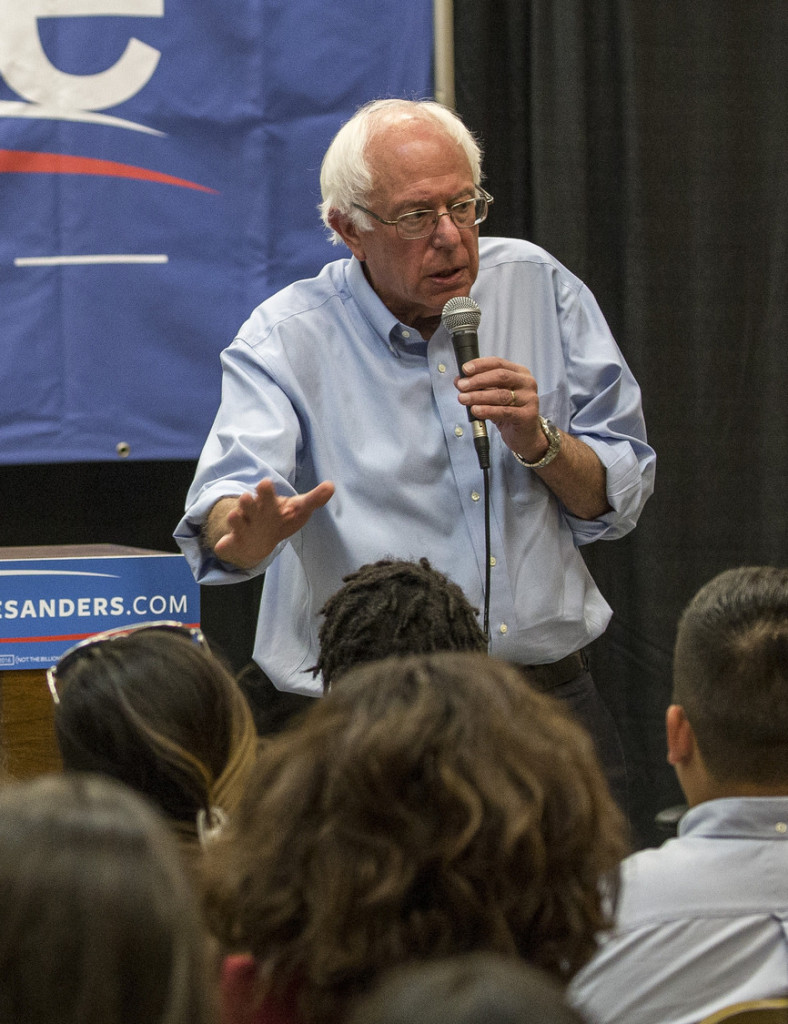The 2016 Election – An MRI on America

Donald Trump in Reno, Nevada. Source, (CC) Darron Birgenheier
Washington – From its raw beginnings to its stunning finale, the presidential campaign of 2016 has been a political earthquake, a broad populist rebellion that has shattered the landscape of power within both major political parties.
The entire narrative of this campaign has been driven by a revolt from the bottom up, by two candidates giving voice to the forgotten against the fortunate, the powerless against the prosperous, the worried against the well-heeled, the stagnant middle against the satisfied elite.

Sen. Bernie Sanders Des Moines, Iowa. Source, (CC) Phil Roeder
It took root in Bernie Sanders’s astonishing and nearly successful revolt against Wall Street and the power elite of the Democratic Party and Donald Trump’s brazen and successful challenge against a field of experienced politicos and establishment candidates in the Republican primaries.
The final act, Trump’s unexpected, cataclysmic victory over Hillary Clinton, became the most dramatic explosion of a populist backlash against the nation’s power elite since the election of Andrew Jackson in 1828.
New Political Fault Lines
For a moment, set aside the partisan outcome of this election and think of Campaign 2016 as an MRI on America. Over the past 15 months, the campaigns of Trump and Sanders have exposed what Arnold Toynbee, the great British historian who studied the rise and fall of 21 human civilizations, called “schisms in the soul” of our society.
Typically, American presidential campaigns turn on a polar clash of Left vs. Right, Conservative vs. Liberal, Republican vs. Democrat. Those are vertical fault lines that separate us philosophically as a people.
But not this year. The political prairie fires lit by Trump and Sanders were kindled by the horizontal, up-down divisions in today’s America, seismic fault lines of wealth, power, and unequal economic destinies that now deeply divide American society, gaping inequalities that have been building in this country over the last three decades, a disturbing narrative told in Who Stole the American Dream?
An Echo of Andrew Jackson in Trump
What the Clinton camp, the power elite in both parties and the media failed to recognize is that Trump was so hard to derail, deflate or defeat, despite his barnyard expletives, sexual predations, and rabid rants against minorities, because he gave voice to what’s churning in the belly of America this year: A volcanic anger among tens of millions of middle- and working-class Americans over being cut out of their fair share of America’s economic growth and not being listened to by the political Powers-That-Be.

Andrew Jackson
In that, Trump’s victory is a modern echo of Andrew Jackson’s upstart victory in the 1828 presidential election. Jackson was a political outsider from Tennessee running against the leader of the Eastern Establishment, President John Quincy Adams. Trade and jobs were big issues. Jackson railed against the so-called “Tariff of Abominations” of 1828. He built wide grass roots appeal among the newly formed states of the Middle West by casting himself as the protagonist of the Common Man.
So, too, Donald Trump, another political outsider who challenged the economic orthodoxy of his own Republican Party as well as the Democratic establishment champion, Hillary Clinton. Like Jackson, Trump savaged trade agreements signed or sought by Democratic Presidents Bill Clinton and Barack Obama, and he built a broad political base by riding mass resentment against the ebb tide of American jobs flowing to Asia. That paid off politically as Trump swept to unexpected victories in pivotal states like Florida, North Carolina, Pennsylvania, Ohio and Michigan, that were among the states most hard-hit by job losses to foreign trade. (See maps below from the Economic Policy Institute)
With two-thirds of Americans telling pollsters that the country was on the wrong track, Trump tapped into popular anger at the grass roots by vowing, like Jackson, to shake up the status quo, and that vow became an unbreakable bond with his base and thus his springboard to the presidency.
In fact, the more Trump was denounced and rejected by Authority in his own party (for example, the two Presidents Bush and Republican presidential nominees, former Gov. Mitt Romney and Senator John McCain of Arizona), the more that added to Trump’s credibility as an authentic agent of change among the more than his 59 million Americans who voted for him.
The Gut Issue Is Wedge Economics
 What the Trump victory underscores is that the gut issue for America today is what I call “wedge economics” – the wedge between the nation’s economic growth and the middle class standard of living. Both growth and a rising living standard used to rise together. But in the late 1970s, the wedge emerged and has widened ever since. Growth and productivity have risen dramatically over the past 30 years, but hourly wages of the average worker have been stagnant.
What the Trump victory underscores is that the gut issue for America today is what I call “wedge economics” – the wedge between the nation’s economic growth and the middle class standard of living. Both growth and a rising living standard used to rise together. But in the late 1970s, the wedge emerged and has widened ever since. Growth and productivity have risen dramatically over the past 30 years, but hourly wages of the average worker have been stagnant.
 While corporate profits and CEO pay have roared ahead in recent years, median household income is below what it was in 2007 and in 1999, even after a strong 5.2% surge in wages in 2015. Bad as they are, those numbers do not capture the angst of families and communities through the Rust Belt Middle West and other industrial center from Texas to California, where factories have closed and communities have been hollowed out as American multi-national corporations shipped millions of jobs overseas – 3.2 million jobs to China alone, according to economist Rob Scott of the Economic Policy Institute.
While corporate profits and CEO pay have roared ahead in recent years, median household income is below what it was in 2007 and in 1999, even after a strong 5.2% surge in wages in 2015. Bad as they are, those numbers do not capture the angst of families and communities through the Rust Belt Middle West and other industrial center from Texas to California, where factories have closed and communities have been hollowed out as American multi-national corporations shipped millions of jobs overseas – 3.2 million jobs to China alone, according to economist Rob Scott of the Economic Policy Institute.
 As Trump understood, these inequalities deeply rankle average Americans. The cleavage among us is not just unequal incomes, but a perceived inequality of power, of unequal gains and losses from international trade, inequality of who sets the nation’s agenda, inequality of economic security and opportunity, and inequalities of political voice and influence in an arena framed by Citizens United and dominated by dark money.
As Trump understood, these inequalities deeply rankle average Americans. The cleavage among us is not just unequal incomes, but a perceived inequality of power, of unequal gains and losses from international trade, inequality of who sets the nation’s agenda, inequality of economic security and opportunity, and inequalities of political voice and influence in an arena framed by Citizens United and dominated by dark money.
Lessons of 2016 – We Ignore Inequality at Our Peril
Donald Trump was able to ride the politics of class resentment in 2016, because the narrative of political revolt was set in motion years earlier by the flash protests of Occupy Wall Street in 2009 and right-wing rumble of the Tea Party in 2010 and beyond. Even during recovery, economic grievances festered in the body politic.
Adding to economic grievances, Trump was able to exploit the festering cultural discomfort of many middle-aged and older white voters, especially in rural areas, with a black president, a woman running for the White House, the recent legalization of gay marriage, and the rising political and economic role of ethnic minorities in American life. As exit polls show, white voters were the core of Trump’s constituency, giving him a 58% to 37% advantage over Clinton.
Finally, when Trump shrieked about a “rigged” political system, he was tapping into well-documented public discontent and suspicion of Washington and the nation’s central political institutions. For years, pollsters reportied that 80% to 90% of Americans feel our political system is broken, that corporations and special interests have too much power, and that Washington does not listen to average Americans.
When it comes to relieving the mass angst and anger that Trump has exploited, he has given us very few specifics about what he will do, other than brashly vowing to rewrite U.S. trade agreements and forcing Mexico to pay for a border wall to stopt Mexican immigration. Nor is it clear how Congressional and corporate Republicans, whose trickle-down economics he has rejected, will respond.
But what is clear from the political earthquake that propelled Donald Trump to power this year is that our leaders, whether in Washington, on Wall Street, or in Corporate America, can no longer afford to ignore the mass anger over our huge and unfair economic divide or the country will face even more political turmoil in the years ahead.


 Hedrick Smith, who conceived this website and is its principal writer and architect, is a Pulitzer Prize-winning former New York Times reporter and Emmy award-winning documentary producer for PBS and PBS FRONTLINE.
Hedrick Smith, who conceived this website and is its principal writer and architect, is a Pulitzer Prize-winning former New York Times reporter and Emmy award-winning documentary producer for PBS and PBS FRONTLINE. 


